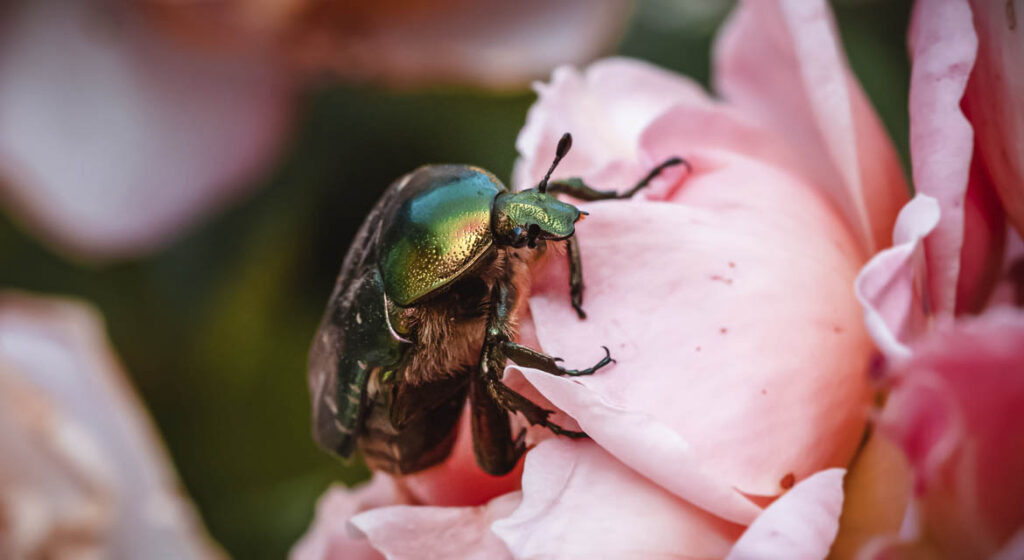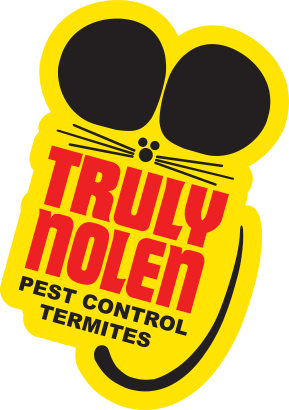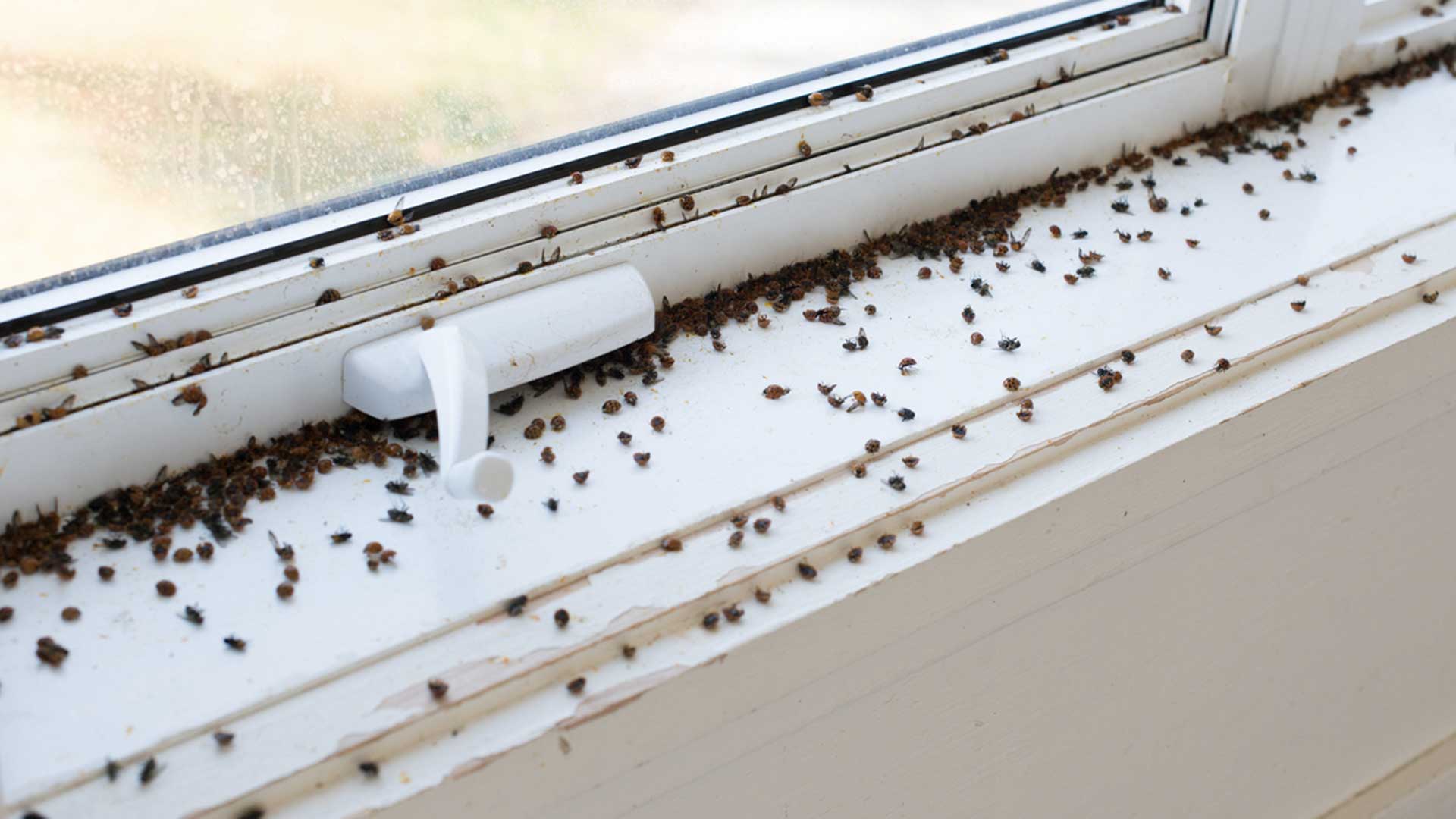
How Can I Prevent a Beetle Infestation?
Prevent beetle infestations by sealing entry points in your home to keep them out and practicing proper storage and sanitation, including using sealed containers for food. Additionally, maintain your outdoor environment by trimming vegetation, removing decaying plant matter, and ensuring proper drainage to eliminate beetle breeding grounds. Here are three things to do in order to prevent a beetle infestation:
- Seal entry points to prevent beetles from entering your home by inspecting and closing cracks, gaps, and openings in the exterior.
- Practice proper storage and sanitation by using sealed containers for food, regularly cleaning and vacuuming, and paying attention to beetle-prone areas.
- Maintain your outdoor environment by trimming vegetation, removing decaying plant matter, and ensuring proper drainage to eliminate beetle breeding grounds.
Beetle Infestation Overview
A beetle infestation occurs when a large number of beetles invade an area and cause damage to trees, plants, or other structures. Beetles are a common problem in North America, with various species of bark beetles, wood-boring beetles, and carpet beetles causing significant damage to thousands of trees every year. They can also infest homes and buildings, damaging furniture and other materials.
Beetle infestations typically begin when adult beetles lay eggs in the bark of trees or other plants. When the eggs hatch, the larvae feed on the inner bark and tissues of the tree or plant, causing damage and weakening the structure. As the larvae grow and develop, they may pupate and transform into adult beetles, which then go on to mate and lay more eggs.
Identifying Trees Susceptible to Beetle Infestations
Beetle infestations can quickly become a nightmare for a homeowner or property manager. These pests can cause extensive damage to trees and plants, eventually killing them if left untreated. One of the key factors in preventing beetle infestations is identifying nearby trees that are susceptible to attack. Knowing which trees are at higher risk can help you take proactive steps to prevent the spread of these pests to your property.
The first step in identifying susceptible trees is to learn the types of beetles that are common in your area. North America is home to many different species of bark beetles, wood-boring beetles, and other types of beetles that can cause significant damage. For example, mountain pine beetles are a common pest that attacks pine trees, while Japanese beetles are known for their appetite for foliage and are often found on high-value ornamental trees.
Once you have an idea of the types of beetles in your area, you can identify nearby trees that are at risk. The most vulnerable trees are those that are stressed or weakened due to disease, drought, or other environmental factors. Pay attention to the bark of trees, as this can provide clues about their health. Bark that is cracked, peeling, or flaking off is a sign that the tree may be stressed or weakened. Trees with thin bark are more vulnerable to attack as well, as they offer less protection to the tree’s interior.
Finally, consider the proximity of nearby host trees. Beetles can easily spread from one tree to another, so it’s crucial to identify trees in your area that are already infested or otherwise at risk. Treat or remove these trees as soon as possible to prevent the spread of beetles to healthier trees.

Truly Nolen GUARANTEE
If you’re not completely satisfied, you’ll get a full refund on your most recent service with our 100% money back guarantee.

$50 Off Year Round Pest Control
Truly Nolen is a family-owned company with 85 years of experience providing the best pest control. If you’re not completely satisfied, you’ll get a full refund on your most recent service with our 100% money back guarantee.
Signs of Beetle Infestation in Trees
Identifying the signs of beetle infestation is crucial for catching the problem early and taking action to control it. Here are some common signs that your tree may be infested with beetles:
- Small holes in the bark: Beetle larvae often burrow into the wood of trees, leaving behind small, round holes in the bark.
- Sawdust-like frass: As beetle larvae feed on the wood, they create tunnels and produce a sawdust-like substance called frass.
- Dead or dying branches: Beetle infestations can weaken a tree’s structure and cause branches to die off.
- Discoloration or streaking on the bark: Some beetle species, such as the mountain pine beetle, can cause discoloration or streaking on the bark of trees they infest.
- Presence of adult beetles: In some cases, you may be able to see adult beetles on or around your tree. Different types of beetles have different appearances, so you need to properly identify the species before taking action to control the infestation.
If you observe any of these signs on your tree, take action to control the infestation as soon as possible. Contacting a pest management professional or arborist can help you identify the type of beetle and determine the best course of treatment.
DIY Treatments for Beetle Infestations
Beetle infestations can be incredibly frustrating, whether they’re in your home or attacking your trees and plants. While professional pest management services can help, they can also be expensive. Fortunately, there are a number of effective DIY treatments that can help you reclaim your space and keep beetles at bay.
One of the most effective DIY treatments for adult beetles is a homemade insecticide spray with soapy water. Simply mix a few tablespoons of dish soap with a quart of water and spray it directly onto the beetles when you see them. The soap will disrupt their shell-like wings and cause them to dehydrate and die. This treatment can work well for carpet beetles, drugstore beetles, and elm leaf beetles.
Another natural DIY treatment that can be effective against beetle larvae is diatomaceous earth, a powder made from the fossilized remains of ancient marine organisms. When beetles come into contact with diatomaceous earth, it pierces their exoskeletons and causes them to dehydrate and die. Be sure to wear gloves and a mask when applying diatomaceous earth, as it can be harmful when inhaled.

$50 Off Year Round Pest Control
Truly Nolen is a family-owned company with 85 years of experience providing the best pest control. If you’re not completely satisfied, you’ll get a full refund on your most recent service with our 100% money back guarantee.
Choosing Beneficial Insects to Control the Beetle Population
If you’re looking for an eco-friendly and natural way to control the beetle population in your garden or backyard, using beneficial insects may be the way to go. Beneficial insects are insect species that help to control pest populations by preying on them or parasitizing their eggs. Not only are they effective, but they are also a safer alternative to harmful chemicals like insecticides that can cause environmental damage and harm to beneficial insects and other wildlife.
There are many types of beneficial insects that can help control beetles, including ladybugs, lacewings, ground beetles, and rove beetles. Each of these insects has unique characteristics, including a preference for different types of beetles and environmental conditions. Therefore, it’s essential to choose the right one for your specific problem.
Ladybugs can consume up to 50 aphids per day, making them an excellent means of controlling the population of species like the Japanese beetle. Similarly, lacewings are another beneficial insect that prey on leafhoppers, mites, and aphids and can control the population of carpet beetles.
Ground beetles and rove beetles are both excellent predators of other beetle species and can be used to control populations of bark beetles, wood-boring beetles, and other plant-eating species. Ground beetles are more active during the night and are attracted to light, while rove beetles are active during the day and prefer to hunt in the shadowy areas under leaves.
Keep in mind that beneficial insects need a sustainable habitat to thrive in. Planting native species of flowers, providing shelter with shrubs or brush piles, and avoiding the use of insecticides are all ways to create a suitable environment for beneficial insects.
Applying Insecticide Treatments to Individual Trees or Entire Areas
When it comes to preventing beetle infestations, insecticide treatments can be a powerful tool. Insecticides are chemical compounds that are designed to kill or repel insects, and they come in many different forms, including sprays, baits, and systemic treatments.
One approach to using insecticides is to apply them directly to individual trees that are susceptible to beetle attacks. This can be an effective way to protect high-value ornamental trees, fruit trees, or other trees that are important to your landscaping. Make sure to follow the manufacturer’s instructions carefully and apply the insecticide at the right time of year for your specific region and tree species.
Another approach is to apply insecticide treatments to entire areas to prevent beetle infestations from taking hold in the first place. This can be particularly useful in areas where pine bark beetles or other types of beetles are common. In these cases, you can apply insecticide treatments to the trees in the surrounding area, creating a barrier of protection that can prevent beetles from moving further into your property.
When Should You Hire a Professional for a Beetle Infestation?
While there are some steps you can take on your own to prevent and manage beetle infestations, there may come a time when you need to hire a professional pest management company like Truly Nolen to deal with the problem effectively.
One situation where it makes sense to call in a professional is when you have a large infestation. If you’re seeing beetles in large numbers on your property, there are probably many more hiding in areas that are difficult to see or access. In these cases, a professional can use specialized equipment and techniques to target the infestation at its source and eliminate it quickly and safely.
Another situation where it may be necessary to hire a professional is when you’re dealing with a species that is particularly difficult to control. Some species, such as Japanese beetles or mountain pine beetles, are known for their resilience and ability to survive under a variety of conditions. In these cases, a professional pest management company can provide targeted treatments tailored to the specific beetle species and population.
In addition, if you have a beetle infestation in a sensitive area, such as a food processing plant or healthcare facility, it may be necessary to hire a professional who has experience working in these environments. Pest management professionals who specialize in these areas have specific training and knowledge about how to effectively control pests in these sensitive areas without posing a risk to people or products.
Finally, if you’re concerned about the potential health risks of insecticides or other pest control products, it may be best to hire a professional. Truly Nolen professionals are trained to use these products safely and effectively, reducing the risk of exposure to the products themselves and any harmful residues they may leave behind.
How Do Professionals Treat Beetle Infestations?
The strategy professionals use to treat a beetle infestation depends on the type of beetle involved, the severity of the infestation, and the location and extent of the damage.
One of the first things a Truly Nolen professional will do is identify the species of beetle involved. Different types of beetles have different habits and behaviors, and they respond differently to different types of treatments.
Once they have identified the beetle species, the professional will assess the extent of the infestation. In some cases, beetles may be localized to a single tree or area, while in other cases they may have spread to neighboring trees or across an entire property. The severity of the infestation will help determine the appropriate level of treatment needed to eliminate the beetles.
From there, pest management professionals will develop a treatment plan that is tailored to the specific beetle species and infestation. This may involve a combination of spraying insecticides, applying preventive treatments, and using trapping and monitoring techniques to assess the effectiveness of the treatments.
Some infestations may require systemic treatments, which means the treatment is absorbed by the tree. These treatments are designed to provide long-lasting control of the beetles and may require multiple applications over a period of time to achieve full control.
In addition to treating the infestation, Truly Nolen will offer advice on how to prevent future infestations from occurring. This may involve steps like removing dead trees and wood debris, improving tree stress and vigor, and reducing beetle habitat and breeding sites.
How to Prevent Another Infestation After Treatment
After dealing with a beetle infestation in your trees or home, the last thing you want is for it to happen again. Fortunately, there are steps you can take to prevent another infestation from occurring:
- Proper identification: Properly identifying the type of beetle that caused the infestation is crucial in preventing it from happening again. Once identified, research the beetle’s habits and what trees or areas it’s attracted to.
- Regular inspection: Checking trees and wooden structures regularly for signs of beetle activity can help catch the problem early, before it becomes a full-blown infestation.
- Tree care: Adequate watering, fertilizing, and pruning can help maintain the tree’s health and vigor and reduce stress that may make it susceptible to beetle attack.
- Clean surroundings: Beetles are attracted to decaying wood and other beetles, so removing dead trees and wood debris can help prevent attracting unwanted visitors.
- Insecticide treatments: Applying insecticide treatments to your trees or wooden structures can be an effective way to prevent future infestations.
- Beneficial insects: Introducing beneficial insects, like ladybugs or nematodes, can help control or prevent beetle infestations. Ladybugs are natural predators of aphids and other pests, while nematodes can seek out and infect beetle larvae.
Consult a professional: Consulting Truly Nolen can provide peace of mind and ensure that your preventive measures are effective. They can offer a thorough inspection of your property and recommend the best treatment and prevention strategies.

$50 Off Year Round Pest Control
Truly Nolen is a family-owned company with 85 years of experience providing the best pest control. If you’re not completely satisfied, you’ll get a full refund on your most recent service with our 100% money back guarantee.
Frequently Asked Questions
How do I identify the type of beetle infesting my property?
Identifying beetles can be challenging due to their vast diversity. However, you can start by noting the beetle’s physical characteristics, such as size, shape, color, and unique features. It can be helpful to consult with a pest control professional or use online resources and identification guides for accurate identification.
Are all beetles harmful or destructive?
No, not all beetles are harmful or destructive. While some beetles can cause damage to crops, stored products, or wooden structures, many beetles play beneficial roles in ecosystems, such as pollination and decomposition.
Can beetles be controlled using DIY methods?
DIY methods can help manage small beetle infestations or prevent them from occurring. This may include maintaining proper sanitation, sealing entry points, removing potential food sources, and using insecticidal sprays or traps. However, for larger or persistent infestations, it is often recommended to seek professional pest control services.
Are beetles harmful to humans or pets?
Most beetles are not harmful to humans or pets. However, some beetles, such as blister beetles, can release irritating substances or have bites that may cause allergic reactions or skin irritations. It’s essential to avoid direct contact with unfamiliar beetles and consult with a medical professional if any adverse reactions occur. Learn More!
How can I prevent beetle infestations?
Preventing beetle infestations involves maintaining good hygiene, removing potential food sources, sealing entry points, and implementing pest-proofing measures. Regular inspection and early detection of any signs of beetle activity can also help prevent infestations from becoming more significant problems. Learn more about beetles

